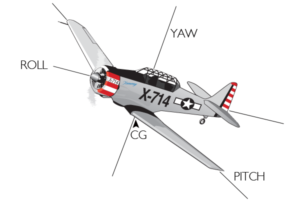We have discussed how Tommy’s wing keeps him aloft and how his radial engine spinning his propeller pulls him through the air. But we have not discussed the need to Balance Tommy and how the flight controls work to make this happen. We also need to talk about Weight & Balance.
Let’s tackle that first since without it Tommy would possibly never get off the ground or be able to even fly.
In the wing description we will talk about how much weight Tommy’s wing will support. Every aircraft has basically two important weights to remember. It’s Empty Weight, the weight of the aircraft with its installed equipment, seats, instruments, radios, and engine oil. Then you have its Maximum Takeoff Weight, this includes the pilot (or pilots), baggage and fuel. Larger Aircraft have additional weights to be concerned about, but we will just address Tommy and the T-6 Texan here.
 Now for, Balance. When you ride a two-wheel bike, you have to balance or you will fall over, right? Well, an aircraft must balance not only nose left and right, they call that YAW, but also nose up and down, called PITCH, as well as left and right, or ROLL. It must balance about those 3 Axes. The controls that help to do this are on the tail of the fuselage the Rudder (for Yaw), the Elevator (for Pitch), and out there on the trailing edge of the wings, Ailerons (for the Roll axis).
Now for, Balance. When you ride a two-wheel bike, you have to balance or you will fall over, right? Well, an aircraft must balance not only nose left and right, they call that YAW, but also nose up and down, called PITCH, as well as left and right, or ROLL. It must balance about those 3 Axes. The controls that help to do this are on the tail of the fuselage the Rudder (for Yaw), the Elevator (for Pitch), and out there on the trailing edge of the wings, Ailerons (for the Roll axis).
Imagine balancing an aircraft on the head of a pin. By adjusting the weights and the three controls with Trim, that is exactly what you must do for controlled flight.
In the next 4 posts we will discuss each of these topics in more detail. Stay tuned!
Blue Skys and Tailwinds,
Captain Billy
